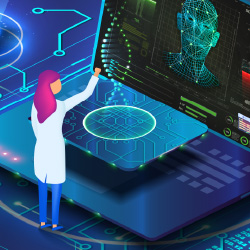 Are you ready to take your passion for computer science, mathematics, biology, or chemistry to the next level? If you’re currently pursuing one of these undergraduate or graduate degrees, you might have come across the field of bioinformatics. A unique blend of cutting-edge research, hands-on application, and complex technology, bioinformatics promises a healthy career trajectory full of exciting scientific discoveries.
Are you ready to take your passion for computer science, mathematics, biology, or chemistry to the next level? If you’re currently pursuing one of these undergraduate or graduate degrees, you might have come across the field of bioinformatics. A unique blend of cutting-edge research, hands-on application, and complex technology, bioinformatics promises a healthy career trajectory full of exciting scientific discoveries.
Bioinformatics could be the next step in your education and skills as this field gives unparalleled opportunities to bring scientific theory to modern-day problem-solving.
What Is Bioinformatics?
A unique and relatively new field, bioinformatics is a scientific subdiscipline that heavily utilizes computer technology. Bioinformatics blends biotechnology, computer sciences, statistics, engineering, and molecular biology and then uses technology to analyze and research extensive data sets like the human genome.
For example, some of the earliest bioinformatics work was the Human Genome Project in the 1990s, one of the most incredible feats in scientific history. It generated the first sequence of human DNA and allowed researchers to read our DNA blueprint for the first time; it went on to improve the overall practice of medicine, furthered research into genetic disorders, and helped researchers investigate disorders of the past. Current bioinformatics work occurred during the COVID-19 pandemic with contract tracing.
Bioinformatics work can take place in a variety of settings, from research laboratories to pharmaceutical companies to educational institutions, and many jobs are located in medical research hot spots like California, Maryland, and Massachusetts.
Want More Career-focused News? Subscribe to Build Your Career Newsletter Today!
Bioinformatics Industry Growth Projection
This fascinating and mission-critical work in bioinformatics shows a promising career trajectory as well. The U.S. Bureau of Labor and Statistics forecasts a 22% growth rate in computer-based analysis jobs by 2030, which is 4x higher than the growth rate for the average industry. Moreover, the field of bioinformatics itself projects a compound annual growth rate of 16.3, hitting a market value of $45.6 billion by 2030.
With an estimated 38,700 bioinformatics scientists in the U.S., this field will only get more popular as technology becomes more advanced, data set sizes increase, and the use of computer technology becomes necessary for complex medical research. 2.5 terabytes of data are made every day, and as technology usage increases, the ability to turn massive data sets into critical, action-oriented insights will be a highly valuable skill.
The average salary for bioinformaticists can also vary; as of December 2022, the average pay was $170,000, with the highest salaries around $200,500 and the lowest around $90,500.
Bioinformatics Skills and Education
Bioinformatics sits at the intersection of several computational science fields, utilizing biology, physics, mathematics, and computer science backgrounds. Therefore, a master’s degree and in-depth technical skills in biology, data mining, genetics and genomics, sequencing tools, statistical software, machine-learning tools, programming languages, and database management tools are typically required.
On a day-to-day basis, bioinformaticists implement algorithms and develop tools for bioinformatics or are curators of data resources and data integration. Bioinformaticists typically work in a multidisciplinary team, and their daily tasks might revolve around developing new systems and databases to analyze data or writing code to automate data processing.
Download “Bioinformatics: At the Intersection of Computer Science, Mathematics, and Biology”
While bioinformatics is not for the faint of heart (or those weary of formal education), it promises an exciting career on the cutting edge of innovation. For those fascinated with machine learning and programming who want to further research and development, bioinformatics could be the career path for you.
If you’re interested in a field other than bioinformatics, explore other career guides and conference reports in our popular resource library. To learn more about a career in bioinformatics, download our free guide here.